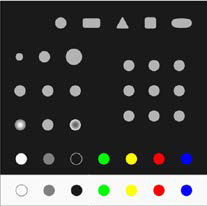Interdisciplinary Methodology for Design. Design of a device for the evaluation of movement disorders
##plugins.themes.bootstrap3.article.main##
Abstract
The present article aims to propose a practical and simple methodology for the interdisciplinary work in the field of design. The proposal is made through the specific case of the design of a device for the evaluation of movement disorders, which is part of the Institutional Project Regularities for the design of domestic interfaces for use in patients with Parkinson's disease. For the final design, it was necessary to take into account three disciplines: Psychology, Design and Electromedicine. It was necessary to establish a methodology that would allow organizing the knowledge and establishing guidelines that facilitate the production of Design taking into account the contributions from other disciplines. The proposed methodology will allow a guide for interdisciplinary work in an efficient and organized way.
 
##plugins.themes.bootstrap3.article.details##

This work is licensed under a Creative Commons Attribution-NonCommercial-ShareAlike 4.0 International License.
- Attribution ‚ÄĒ You must give appropriate credit , provide a link to the license, and indicate if changes were made . You may do so in any reasonable manner, but not in any way that suggests the licensor endorses you or your use.
- NonCommercial ‚ÄĒ You may not use the material for commercial purposes .
- No additional restrictions ‚ÄĒ You may not apply legal terms or technological measures that legally restrict others from doing anything the license permits.
- ShareAlike ‚ÄĒ If you remix, transform, or build upon the material, you must distribute your contribution under the same license as the original. NOTE: This point applies to numbers 1 to 20 of the magazine with the previous CC-BY-NC-SA 4.0 license. Does not apply to the new CC BY-NC 4.0 license from Volume 11, Number. 21 (2024).
References
Abras, C., Maloney-Krichmar, D., & Preece, J. (2004). User-centered design. In Bainbridge, W. Encyclo- pedia of Human-Computer Interaction. Thousand Oaks: Sage Publications, 37(4), 445-456.
Coleman, R. (1994). The case for inclusive design - An overview. In Proceedings of the 12th Triennial Con- gress of the International Ergonomics Association. Toronto: International Ergonomics Association.
Corel. (2011). Corel Draw. Dallas, Texas, USA.
Del Tredici, K., & Braak, H. L. (2012). Payhology and Neurodegeneration in Premotor Parkinson¬īs Disea- se. Movement Desorders, 5(27), 597-607.
EIDD. (2004). Stockholm Declaration. Obtenido de Design for All Europe: http:// www.designfora- lleurope.org/Design-for-All/EIDD-Documents/Stoc- kholm-Declaration/
Fahnm, S., Jankovic, J., & Hallet, H. (2011). Princi- ples and practiceof movement disorders (2 ed.). Lon- don: Elsevier.
Giroud, J. B., Collado-Mesa, F., & Esteban, E. M. (2000). Prevalence of Parkinson disease in an urban area of Ciudad de La Habana province, Cuba. Door- to-door population study. Neurologia, 15(7), 269-273. Imrie, R., & Hall, P. (2001). Inclusive Design: Desig- ning and Developing Accessible Environments. Lon- don: Spon Press.
Mace, R. (1985). Universal design: Barrier free envi- ronments for everyone. Designers West, 33(1), 147-152.
Maetzler, W., & Hausdorrf, J. (2012). Motor Signs in the Prodromal Phase of Parkinson¬īs Desease. Move- ment Disorders, 5(27), 627-633.
Mao, J. Y., Vredenburg, K., Smith, P. W., & Carey,
T. (2005). The state of user-centered design practice. Communications of the ACM, 48(3), 105-109.
Nielsen, J. (1994). Usability engineering. . Elsevier.
Norman, D. A., & Draper, S. W. (1986). User-Cen- tered System Design: New Perspectives on Human- Computer Interaction. . Hillsdale, NJ.: Lawrence Earlbaum Associates.
Preece, J., Rogers, Y., & Sharp, H. (2002). Interaction design: Beyond human-computer interaction. New York: John Wiley & Sons, Inc.
Preiser, W., & Ostroff, E. (2001). Universal Design Handbook. New York: McGraw-Hill.
Steinfeld, E., & Tauke, B. (2002). Universal desig- ning. En Universal Design. 17 Ways of Thinking and Teaching (J. Christophersen ed., p√°gs. 165-189). Norway: Husbanken.
Tamayo y Tamayo, M. (2004). Diccionario de la inves- tigación científica (Segunda ed.). México: Limusa.
Tinazzi, M., Del Vesco, C., Fincati, E., Ottaviani, S., Smania, N., & Moretto, G. (2006). Pain and mo- tor complications in Parkinson¬īs Disease. Journal of Neurology and Neurosurgery Psychiatry(77), 822-825.
Waterfall, M. L., & Crowe, S. F. (1995). Meta-analytic comparison of the comoponents of visual cognition in Parkinson¬īs disease. Journal of Clinic Experimen- tal Neuropsychology(17), 759-772.






















